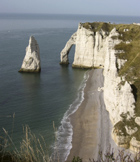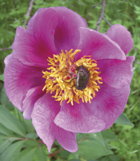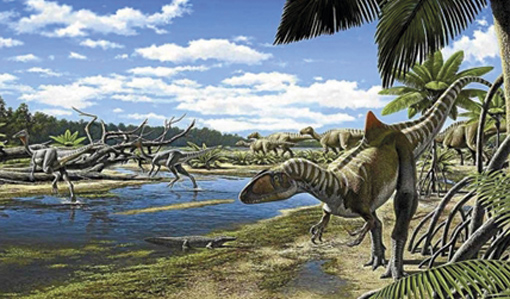
Campus Moncloa
Campus of International Excellence
Cretaceous
145-66 M.a.


Chalk cliffs in Normandy (France).

Paeonnia broteroi (Angiosperma).
Submarine volcanic activity increases greatly during the Cretaceous period creating a super-greenhouse effect. The disintegration of Pangaea accelerates: Eurasia separates from North America and Africa from South America. India breaks off and starts to move northward. The new oceans expand, the sea beds swell and the sea level rises even more. Warm seas and temperate climates promote the diversity of life. Ammonites and reptiles reign in seas full of algae, bivalves and other invertebrates. The dinosaurs continue to dominate the Earth and reptiles the size of aircraft fly across the skies. Meanwhile, mammals diversify and discreetly prosper.
Early angiosperms appear (flowering plants) and they adapt and spread quickly. A 10-kilometre-diameter asteroid impact at the end of the Cretaceous causes a climatic and ecological catastrophe that leads to a new extinction: non-avian dinosaurs, large reptiles and ammonites disappear among others. New environmental conditions favour the expansion of mammals and angiosperms.

Environmental reproduction of Las Hoyas Site (Cuenca, Spain). The animal in the foreground is a Concavenator corcovatus, a dinosaur from the Lower Cretaceous.
| Hadean | ~4600-4000 M.a. |
| Archean | 4000-2500 M.a. |
| Proterozoic | 2500-541 M.a. |
| Cambrian | 541-485 M.a. |
| Ordovician | 485-443 M.a. |
| Silurian | 443-419 M.a. |
| Devonian | 419-359 M.a. |
| Carboniferous | 359-299 M.a. |
| Permian | 299-252 M.a. |
| Triassic | 252-201 M.a. |
| Jurassic | 201-145 M.a. |
| Cretaceous | 145-66 M.a. |
| Paleogene | 66-23 M.a. |
| Neogene | 23-2,6 M.a. |
| Quaternary | 2,6 M.a.-act. |
